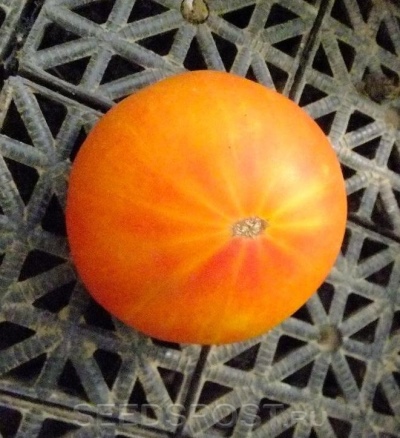
- Authors: selection of the USA
- Category: grade
- Growth type: indeterminate
- Appointment: fresh consumption
- Ripening period: mid-season
- Ripening time, days: 120-130
- Growing conditions: for film greenhouses, for closed ground, for greenhouses
- Bush height, cm: up to 200
- Ripe fruit color: Orange
- Fruit shape: flat-round
Tomato Pineapple is one of the brightest representatives of American selection. The name of the variety should be due to the unusual color of ripe fruits, which makes tomatoes look like an exotic fruit. The variety has recently begun to be grown in domestic plots, but it has already gained great popularity. And this is no coincidence: Pineapple tomatoes have a great taste, as well as long-term fruiting.
Description of the variety
Pineapple bush has an indeterminate type of growth, grows up to 2 m in height. After 8 or 9 leaves, the first brush is laid. Each cluster has 5–6 ovaries.
The main qualities of the fruit
Quite large tomatoes, weighing from 350 to 420 g. The ripe fruit is orange, and the flesh on the cut has an interesting color: it is orange in the middle, and yellow at the edges. The shape of the fruit is flat-round. Tomatoes are highly resistant to cracking, and also perfectly tolerate transportation over a variety of distances, while their commercial qualities are not lost at all.
Taste characteristics
The Pineapple variety is distinguished by simply excellent taste. The fruits are fleshy, sweet, juicy, with fruity notes. The brightest flavor is achieved after full ripening. The purpose of the variety is salad.
Ripening and fruiting
The growing season of the variety under consideration lasts 120–130 days. Thus, it is considered a medium-ripening variety. The crop can be harvested from July to September.
Yield
Official sources note that from 1 m 2 you can get up to 11-14 kg of fruit.
The timing of planting seedlings and planting in the ground
Planting seed for seedlings when cultivating tomatoes Pineapple is best done from March 1 to March 10. The soil mixture should be moist and warmed up to + 20 ° C. The seedlings are transferred to the greenhouse only after the end of all possible frosts, namely: at the end of May or the beginning of June.

Growing tomato seedlings is an extremely important process, because it largely depends on whether the gardener can harvest at all. All aspects must be taken into account, from seedbed preparation to planting in the ground.
Landing scheme
Planting density is of great importance for productivity and ease of crop care. In the case of a tomato Pineapple, this is 2-3 sprouts on an area of 1 m 2 or a scheme of 50X70 cm.

Growing and care
Varietal tomato of American selection is intended primarily for greenhouses, cultivation in foil and glazed greenhouses. After the young plants have passed the preliminary hardening procedure, they are transplanted into a greenhouse to a permanent place of growth. The culture in question is tall, therefore it is recommended to practice the formation of 1-2 trunks.We must not forget that we must pinch her, tie and pinch her. In advance, you need to install strong supports to which the bushes will be tied.
The recommended irrigation schedule is once every 5-7 days, followed by loosening. Irrigation should take place in moderation, waterlogging should not be allowed, otherwise fungal diseases may develop, and this also contributes to root decay.
Complex mineral fertilizing is also important, which will be necessary at the stage of fruit setting. Such feeding is carried out every 2 weeks. They can be supplemented by adding organic fertilizers to the beds, with the exception of fresh manure.
If the care is correct, the Pineapple variety will delight gardeners with a good harvest until the cold weather. The difference of the variety is the fact that by the end of the growing season, the taste characteristics of the fruits only get better, reaching their maximum.




A plant needs different micronutrients at each stage of growth. All fertilizers can be divided into two groups: mineral and organic. Folk remedies are often used: iodine, yeast, bird droppings, eggshells.
It is important to observe the rate and period of feeding. This also applies to folk remedies and organic fertilizers.
Disease and pest resistance
The variety, developed by American breeders, is distinguished by increased immunity to the main ailments of tomatoes.



























































































